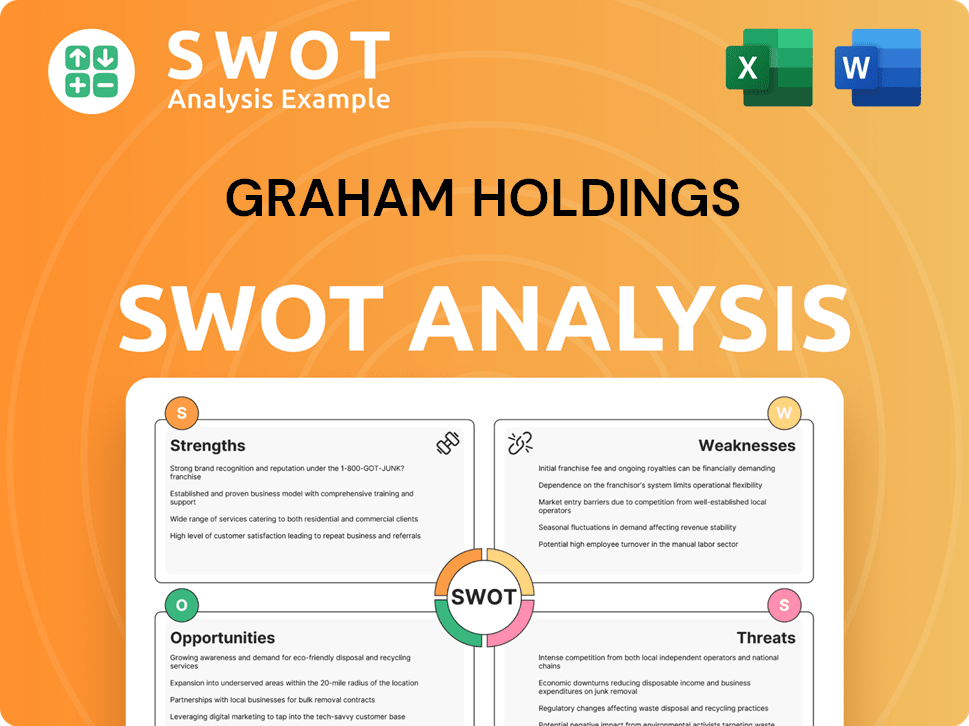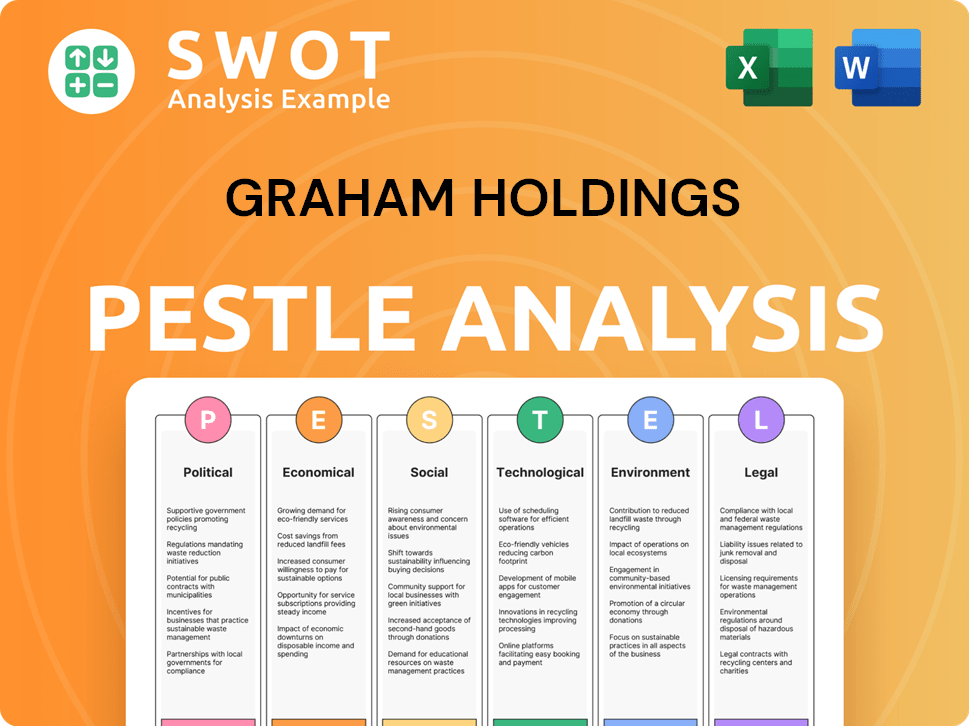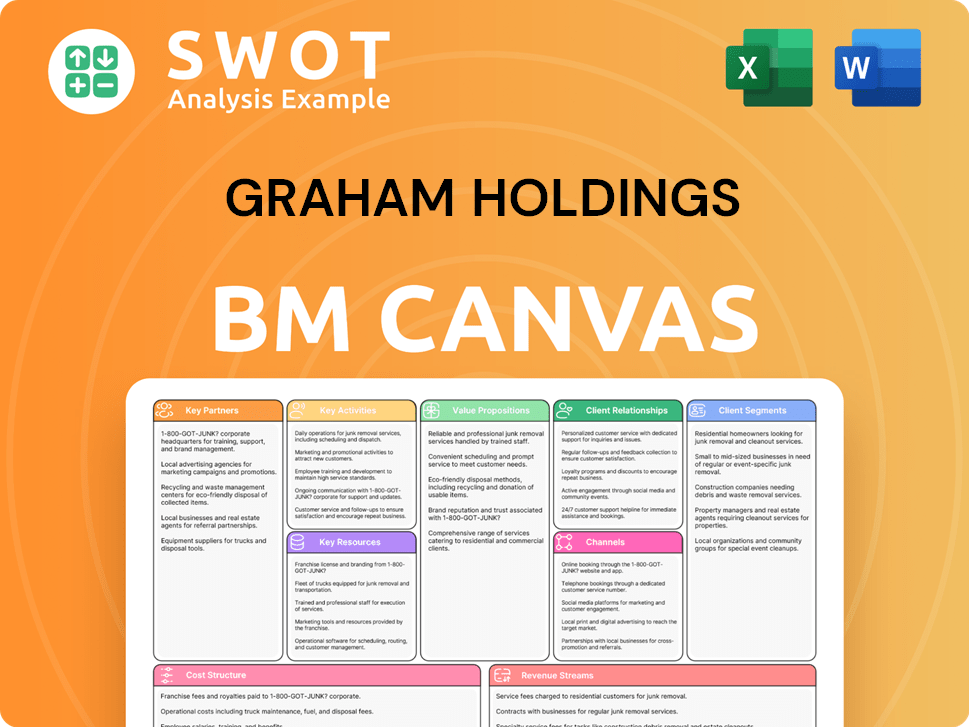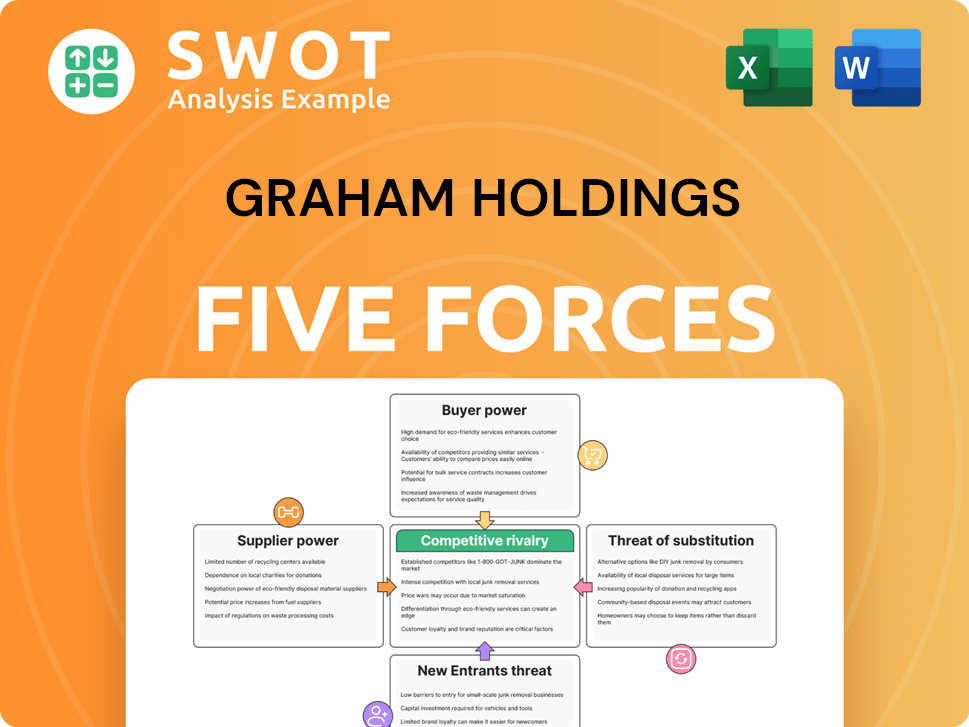Graham Holdings Bundle
Unveiling the Engine: How Does Graham Holdings Company Thrive?
Graham Holdings Company, a diversified American conglomerate, recently showcased its financial prowess, with a notable 9% revenue increase to $4.79 billion in 2024. This impressive growth highlights the company's strategic agility in a fluctuating market. Its diverse portfolio, spanning education, media, and manufacturing, makes it a compelling case study for any investor.

This deep dive into the Graham Holdings SWOT Analysis will explore the intricacies of the GHC business model and its various Graham Holdings operations. We'll examine how Graham Holdings Company generates revenue through its subsidiaries, including Kaplan Inc, and how it navigates the landscape of media companies and other sectors. Understanding the company's financial performance is key to assessing its potential within the context of Warren Buffett investments and the broader market.
What Are the Key Operations Driving Graham Holdings’s Success?
The core operations of Graham Holdings Company (GHC) are structured around a diverse set of businesses, creating value across various sectors. The company's strategic approach involves operating in education, television broadcasting, manufacturing, and healthcare, alongside automotive dealerships and other ventures. This diversified portfolio allows GHC to serve a broad customer base and adapt to different market dynamics.
GHC's value proposition lies in its ability to generate revenue and achieve growth through a mix of established and emerging businesses. The company aims to provide high-quality services and products in each of its operational segments, focusing on customer satisfaction and operational efficiency. By maintaining a diversified portfolio, GHC mitigates risks and capitalizes on opportunities across multiple industries.
The GHC business model is designed to leverage the strengths of each business segment while fostering synergies across the company. This diversification strategy has been a key factor in its long-term performance, allowing it to navigate economic cycles and maintain a strong financial position. The company continually evaluates its portfolio, making strategic decisions to optimize its operations and drive shareholder value. For more insights into the target market, consider reading about the Target Market of Graham Holdings.
Kaplan, Inc., a significant asset within GHC, offers a wide array of educational services to students, schools, colleges, universities, and businesses worldwide. These services include academic preparation programs, English-language training, test preparation, professional training, and operational support for higher education institutions. Kaplan's global reach and diverse offerings contribute significantly to GHC's revenue and overall value.
The television broadcasting segment operates seven television stations across key U.S. markets, including Houston, Detroit, and Orlando. These stations deliver local news, weather, and community information, generating revenue through advertising, including political advertising. The broadcasting segment provides a strong local presence and contributes to GHC's media portfolio.
GHC's manufacturing operations include companies like Hoover Treated Wood Products, Dekko, and Forney Corporation. These companies produce a variety of products, such as fire-retardant lumber, electrical workspace solutions, and combustion monitoring equipment. The manufacturing segment supports diverse industries, including electric utilities, and contributes to GHC's revenue through product sales and services.
Graham Healthcare Group provides home health, hospice, and palliative care services, often through joint ventures with health systems. This segment focuses on delivering essential healthcare services to patients, contributing to GHC's presence in the healthcare industry. The healthcare segment addresses a critical need in the community.
In 2022, Kaplan reported that 78% of its training programs were delivered through digital channels, showcasing its commitment to digital transformation. The television broadcasting segment continues to be a steady revenue generator through advertising sales. The manufacturing operations provide a range of products to various industries, while the healthcare segment focuses on providing essential services.
- The company's diversified structure allows it to serve a wide range of customers.
- GHC's operational efficiency and strategic investments support its financial performance.
- The company's focus on innovation and customer satisfaction drives long-term growth.
- GHC's commitment to adapting to market changes ensures its continued success.
Graham Holdings SWOT Analysis
- Complete SWOT Breakdown
- Fully Customizable
- Editable in Excel & Word
- Professional Formatting
- Investor-Ready Format

How Does Graham Holdings Make Money?
Understanding the revenue streams and monetization strategies of the company provides insight into its financial health and operational approach. The company, a diversified holding company, generates revenue through a variety of businesses, making it a dynamic entity. Its operations span several sectors, including education, television broadcasting, healthcare, and manufacturing.
The company's ability to generate revenue across diverse sectors showcases its resilience and adaptability in the market. By examining each segment's performance, one can better understand the company's overall financial strategy and its potential for future growth. This diversified approach is a key aspect of the Brief History of Graham Holdings.
In 2024, the company's total revenue reached $4.79 billion, a 9% increase from $4.41 billion in 2023. This growth reflects the company's ability to increase its earnings across its various business segments.
The education division, primarily through Kaplan, is a significant contributor to the company's revenue. Kaplan Inc. offers a range of educational services, including test preparation, professional training, and higher education programs. In the fourth quarter of 2024, the education division's revenue totaled $408.2 million, a 3% increase from the same period in 2023.
- Kaplan International's revenue increased by 3% in Q4 2024, driven by growth in Pathways and UK Professional programs.
- The company monetizes its educational services through test preparation, professional training, and higher education programs.
Television broadcasting is another substantial revenue stream for the company. Revenue from television broadcasting increased by 30% to $161.7 million in the fourth quarter of 2024, up from $124.6 million in 2023. This significant rise was primarily due to a $49.7 million increase in political advertising revenue, along with growth in digital advertising.
- The increase in television broadcasting revenue highlights the impact of advertising, particularly political advertising.
- Digital advertising also played a role in the revenue growth.
The healthcare segment also demonstrated strong growth. Revenues increased by 41% in the fourth quarter of 2024, largely due to the performance of CSI Pharmacy Holding Company, LLC (CSI) and other healthcare businesses. This growth indicates the company's successful expansion and management within the healthcare sector.
- The performance of CSI Pharmacy Holding Company, LLC (CSI) was a key driver of growth.
- Other healthcare businesses also contributed to the revenue increase.
While education, television broadcasting, and healthcare segments showed revenue increases in 2024, the manufacturing and other businesses segments experienced some declines. Manufacturing revenues decreased by 9% in the fourth quarter of 2024, mainly due to lower revenues at Hoover, partially offset by increases at Dekko, Forney, and Joyce. In the first quarter of 2025, operating revenues for the company were $1,165.9 million, a 1% increase from $1,152.7 million in the first quarter of 2024. This growth was driven by increases in education, healthcare, and other businesses, partially offset by declines in television broadcasting, manufacturing, and automotive segments.
- Manufacturing revenues decreased due to lower revenues at Hoover.
- Overall, the company's revenue streams are diverse, with varying performances across different segments.
Graham Holdings PESTLE Analysis
- Covers All 6 PESTLE Categories
- No Research Needed – Save Hours of Work
- Built by Experts, Trusted by Consultants
- Instant Download, Ready to Use
- 100% Editable, Fully Customizable

Which Strategic Decisions Have Shaped Graham Holdings’s Business Model?
The operational and financial journey of Graham Holdings Company (GHC) has been shaped by strategic acquisitions and its ability to navigate market challenges. While there weren't any significant new product launches or market expansions highlighted in 2024-2025, the company's financial results demonstrate ongoing strategic management of its diverse portfolio. This approach is crucial for understanding the GHC business model.
In the fourth quarter of 2024, Graham Holdings did not engage in any major business acquisitions or dispositions. However, the company did repurchase 19,672 shares of its Class B common stock for $15.9 million, indicating a focus on shareholder returns. A notable financial event in Q4 2024 was the purchase of an irrevocable group annuity contract for $461.3 million, settling $457.9 million of its defined benefit obligation, resulting in a one-time, pre-tax, noncash settlement gain of $653.4 million.
Graham Holdings' competitive advantages stem from its diversified nature, which provides resilience against sector-specific downturns. Its established brands like Kaplan in education and its portfolio of television stations offer significant market presence and brand strength. The company's ability to generate strong adjusted operating cash flow, which rose to $447.0 million in 2024 from $338.3 million in 2023, also indicates operational effectiveness and financial flexibility. For more insights, explore the Growth Strategy of Graham Holdings.
The company's strategic moves include share repurchases and significant financial transactions like the annuity contract purchase. These actions reflect a focus on shareholder value and financial stability. These events are crucial for understanding the Graham Holdings operations.
Graham Holdings continues to adapt by focusing on growth in its key segments and managing its portfolio to optimize performance. The company's operational income surged to $215.5 million for the full year 2024, a substantial increase from $69.4 million in 2023, driven by improvements in education, television broadcasting, and healthcare.
Kaplan, a key subsidiary, maintains a competitive advantage with a 15.4% market share in global test preparation services. The company's diversified nature provides resilience against sector-specific downturns. The company's strong adjusted operating cash flow is a significant indicator of its financial health.
Despite challenges, such as the long-lived asset impairment charge in its education division, Graham Holdings demonstrated robust financial performance. The increase in operating income and strong cash flow generation highlight the company's effective management and strategic focus. This is a key factor for those asking, 'Is Graham Holdings a good investment?'
Graham Holdings' strategic focus on shareholder returns and operational efficiency is evident in its recent financial activities. The company's diversified portfolio and strong cash flow generation provide a competitive edge in the market. Understanding the GHC business model involves analyzing its strategic moves and financial performance.
- Share repurchases and strategic financial maneuvers.
- Strong growth in operating income, especially in education and media sectors.
- Kaplan's significant market share and operational effectiveness.
- Focus on managing its portfolio to optimize performance.
Graham Holdings Business Model Canvas
- Complete 9-Block Business Model Canvas
- Effortlessly Communicate Your Business Strategy
- Investor-Ready BMC Format
- 100% Editable and Customizable
- Clear and Structured Layout

How Is Graham Holdings Positioning Itself for Continued Success?
The industry position, risks, and future outlook of the Graham Holdings Company (GHC) are shaped by its diversified business model. GHC operates across key sectors, including education, television broadcasting, manufacturing, and healthcare, which allows it to navigate market fluctuations. The company's strategic diversification provides a degree of insulation from downturns in any single industry, which is a key feature of the GHC business model.
However, Graham Holdings faces inherent risks within its diverse operations. The education segment, particularly Kaplan International, can be impacted by external factors such as changes in student visa policies. The television broadcasting segment is susceptible to fluctuations in advertising revenue. Economic downturns, technological disruption, and evolving consumer preferences across its varied businesses also pose ongoing risks. Understanding these elements is crucial for assessing Graham Holdings operations.
Graham Holdings Company maintains a diversified market position. Through Kaplan, it holds a notable position in the global test preparation market. Its television broadcasting arm, Graham Media Group, owns several local TV stations in top-50 markets. This diversification helps to mitigate risks associated with any single industry.
The company faces risks within its diverse operations. The education segment can be impacted by changes in student visa policies. The broadcasting segment is susceptible to fluctuations in advertising revenue. Economic downturns and technological disruptions also pose ongoing risks across its businesses.
Graham Holdings is focused on sustaining and expanding its revenue-generating capabilities. The company's 2024 financial results demonstrate its capacity for growth. The company's strategic focus on its core profitable segments will be crucial for its continued success.
In 2024, Graham Holdings saw a 9% increase in revenue, reaching $4.79 billion. Adjusted operating cash flow grew to $447.0 million in 2024. These figures suggest a healthy financial position to support future initiatives.
Graham Holdings Company's diversified structure provides both opportunities and challenges. The company's ability to adapt to market conditions will determine its future success. For those interested in How does Graham Holdings make money, understanding these dynamics is crucial.
- Diversified business model mitigates risks.
- Education segment faces regulatory and policy risks.
- Focus on core segments and cash flow is vital for growth.
- The company's financial performance in 2024 shows resilience.
Graham Holdings Porter's Five Forces Analysis
- Covers All 5 Competitive Forces in Detail
- Structured for Consultants, Students, and Founders
- 100% Editable in Microsoft Word & Excel
- Instant Digital Download – Use Immediately
- Compatible with Mac & PC – Fully Unlocked

Related Blogs
- What are Mission Vision & Core Values of Graham Holdings Company?
- What is Competitive Landscape of Graham Holdings Company?
- What is Growth Strategy and Future Prospects of Graham Holdings Company?
- What is Sales and Marketing Strategy of Graham Holdings Company?
- What is Brief History of Graham Holdings Company?
- Who Owns Graham Holdings Company?
- What is Customer Demographics and Target Market of Graham Holdings Company?
Disclaimer
All information, articles, and product details provided on this website are for general informational and educational purposes only. We do not claim any ownership over, nor do we intend to infringe upon, any trademarks, copyrights, logos, brand names, or other intellectual property mentioned or depicted on this site. Such intellectual property remains the property of its respective owners, and any references here are made solely for identification or informational purposes, without implying any affiliation, endorsement, or partnership.
We make no representations or warranties, express or implied, regarding the accuracy, completeness, or suitability of any content or products presented. Nothing on this website should be construed as legal, tax, investment, financial, medical, or other professional advice. In addition, no part of this site—including articles or product references—constitutes a solicitation, recommendation, endorsement, advertisement, or offer to buy or sell any securities, franchises, or other financial instruments, particularly in jurisdictions where such activity would be unlawful.
All content is of a general nature and may not address the specific circumstances of any individual or entity. It is not a substitute for professional advice or services. Any actions you take based on the information provided here are strictly at your own risk. You accept full responsibility for any decisions or outcomes arising from your use of this website and agree to release us from any liability in connection with your use of, or reliance upon, the content or products found herein.